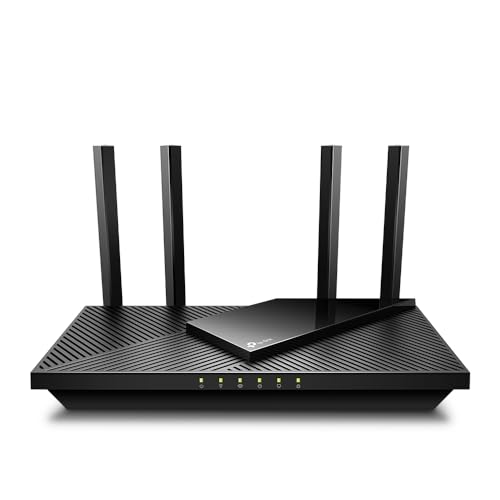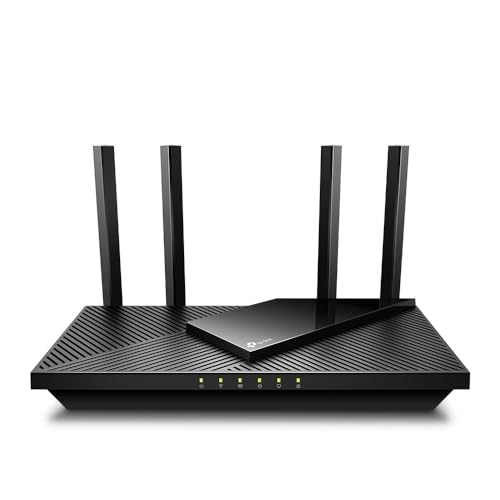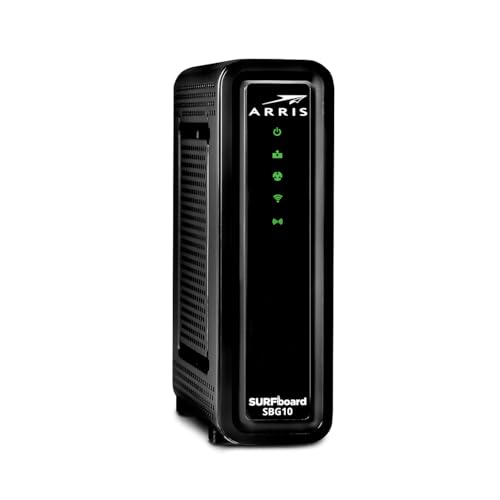Ever feel like your home WiFi is acting up, but you can’t quite pinpoint why? Maybe it’s a mysterious slowdown, a device hogging bandwidth, or simply a desire to keep a closer eye on your digital landscape. That’s where a capable router with robust WiFi network monitoring features comes in handy. It’s not just about raw speed anymore; it’s about control, visibility, and security over your entire home network.
Knowing what’s happening on your network can help you diagnose issues, manage connected devices, enforce parental controls, and even boost your overall internet speed. But with so many options out there, how do you pick the right one? We’ve sifted through the market to bring you our top picks for the best home router for WiFi network monitoring, focusing on features that give you greater insight and command over your internet experience.
Let’s dive into some excellent choices that offer impressive performance alongside those crucial monitoring capabilities.
1. TP-Link AX1800 WiFi 6 Router V4 (Archer AX21)

The TP-Link Archer AX21 stands out as a fantastic all-rounder for those looking to upgrade to Wi-Fi 6 while also gaining valuable control over their network. What truly sets this model apart is its built-in VPN server, offering an extra layer of security and flexibility for remote access or protecting your network’s outgoing traffic. It’s a reliable workhorse that promises faster speeds, greater capacity, and a clearer view of your home’s digital goings-on.
Key Features:
– VPN Server: Supports both OpenVPN Server and PPTP VPN Server.
– DUAL-BAND WIFI 6 ROUTER: Wi-Fi 6 (802.11ax) technology for faster speeds and reduced network congestion.
– AX1800: Up to 1.8 Gbps total bandwidth (1200 Mbps on 5 GHz, 574 Mbps on 2.4 GHz).
– Connect More Devices: OFDMA technology allows communication with more devices simultaneously.
– Extensive Coverage: Beamforming, 4 high-gain antennas, and advanced FEM chipset for strong, reliable WiFi.
– Cybersecurity Commitment: Designed with advanced security in mind as a core requirement.
– Works with all internet service providers.
Pros:
– Built-in VPN server is a significant advantage for privacy and remote access.
– Wi-Fi 6 technology provides future-proofing and better performance for multiple devices.
– Excellent coverage for most homes.
– Strong focus on cybersecurity from the manufacturer.
– Easy management via the TP-Link Tether app.
Cons:
– Only dual-band, not tri-band.
– Like all WiFi routers, requires a separate modem.
User Impressions:
Customers frequently praise the Archer AX21 for its easy setup, stable connection, and the noticeable speed improvement, especially when upgrading from older Wi-Fi 5 routers. The VPN server functionality is a big plus for users concerned about security and wanting more control over their home network from anywhere.
Call to Action:
See it on Amazon Here
2. NETGEAR Nighthawk 6-Stream Dual-Band WiFi 6 Router (RAX54S)

When it comes to comprehensive network protection and powerful performance, the NETGEAR Nighthawk RAX54S is a strong contender. This router isn’t just about raw speed; it’s a security fortress for your home network, thanks to its included NETGEAR Armor subscription. If keeping your family and devices safe from online threats while maintaining peak WiFi performance is a top priority, this Nighthawk model deserves a close look. It’s a fantastic best home router for WiFi network monitoring when security is paramount.
Key Features:
– Coverage up to 2,500 sq. ft. for up to 25 devices.
– Fast AX5400 Gigabit speed with WiFi 6 technology.
– NETGEAR Armor: Automatic shield for WiFi and connected devices (PC, phone, camera, TV, baby monitor, etc.) with real-time protection against hackers and VPN for added privacy (1-year subscription included).
– Automatic firmware updates and industry-leading safety features.
– 4 x 1 Gig Ethernet ports and 1 USB 3.0 port for wired devices and storage.
– Easily set up and manage your WiFi with the Nighthawk app.
– Compatible with any internet service provider up to 1Gbps.
Pros:
– Robust security suite with NETGEAR Armor for comprehensive device protection.
– High AX5400 speeds and Wi-Fi 6 technology for demanding applications.
– Good coverage and capacity for many devices.
– Easy management via the intuitive Nighthawk app.
– Includes a useful USB 3.0 port for network storage.
Cons:
– NETGEAR Armor requires a subscription after the first year.
– Made for use in the U.S. only.
User Impressions:
Users consistently highlight the RAX54S’s strong WiFi signal and reliable performance, especially for gaming and 4K streaming. The added peace of mind from NETGEAR Armor’s security features is a frequently mentioned benefit, making it a favorite for security-conscious households.
Call to Action:
See it on Amazon Here
3. TP-Link Deco S4 Mesh AC1900 WiFi System

For larger homes or those plagued by WiFi dead zones, the TP-Link Deco S4 Mesh System offers an elegant and effective solution. This isn’t just a single router; it’s a multi-unit system that works together to create a unified, seamless network throughout your entire home. While not Wi-Fi 6, its strong mesh technology and robust parental controls make it an excellent choice for family homes seeking consistent coverage and easy device management.
Key Features:
– Deco Mesh Technology: Creates a seamless WiFi mesh network for whole-home coverage up to 5,500 sq. ft. (3-pack).
– Seamless Roaming: Devices automatically switch between Decos for the fastest possible speeds with a single network name.
– Incredibly fast 3×3 6 Stream AC1900 speeds for connectivity up to 100 devices.
– Robust Parental Controls: Limit online time and block inappropriate websites for each family member.
– Easy Setup: Via the Deco app on Android or iOS devices.
– Guest WiFi with Alexa voice commands.
– Each Deco S4 has 2 Gigabit Ethernet ports (6 in total for a 3-pack) and supports Wired Ethernet Backhaul.
Pros:
– Exceptional whole-home WiFi coverage, eliminating dead zones.
– Seamless roaming ensures a consistent connection as you move around.
– Excellent for managing a high number of connected devices.
– Comprehensive and easy-to-use parental controls.
– Simple setup process through the Deco app.
Cons:
– AC1900 speeds are not as fast as Wi-Fi 6 routers.
– For very large or multi-story homes, additional units might be needed.
User Impressions:
Customers rave about how the Deco S4 completely transforms their home WiFi experience, eliminating frustrating dead spots and providing strong signals everywhere. The intuitive parental controls and effortless setup are also frequently cited as major advantages, making it a family-friendly choice.
Call to Action:
See it on Amazon Here
4. TP-Link AC1200 WiFi Router (Archer A54)

If you’re on a budget but still want modern security and decent performance for your home network, the TP-Link Archer A54 is a fantastic option. This dual-band AC1200 router brings the latest WPA3 security protocol to the table, ensuring your network is well-protected. What’s more, its EasyMesh compatibility means you can easily expand your WiFi coverage later on, making it a flexible choice for smaller homes or apartments. It might not be the most advanced for granular WiFi network monitoring, but it provides essential security and expandability.
Key Features:
– Simultaneous 2.4GHz 300 Mbps and 5GHz 867 Mbps connections for 1200 Mbps total bandwidth.
– 4 external antennas for stable wireless connections and optimal coverage.
– Supports IGMP Proxy/Snooping, Bridge, and Tag VLAN to optimize IPTV streaming.
– Access Point Mode: Transforms your wired connection into a wireless network.
– Advanced Security with WPA3: The latest Wi-Fi security protocol.
– EasyMesh Compatibility: Create a Mesh network by pairing with any EasyMesh-compatible device.
– Easy network management with the TP-Link Tether app.
– Works with all internet service providers.
Pros:
– Very affordable entry-point for a modern router.
– Includes WPA3 security for enhanced network protection.
– EasyMesh compatibility offers a clear upgrade path for coverage.
– AP Mode and IPTV optimization are useful additional features.
– Simple management via the Tether app.
Cons:
– AC1200 speeds are lower than Wi-Fi 6 alternatives.
– Monitoring features are more basic compared to higher-end models.
User Impressions:
Reviewers commend the Archer A54 for its excellent value, stable WiFi signal, and straightforward installation process. Many appreciate the inclusion of WPA3 security at this price point, making it a solid choice for those seeking reliability without breaking the bank.
Call to Action:
See it on Amazon Here
5. NETGEAR 4-Stream WiFi 6 Router (R6700AX)

Looking for an affordable way to step into the world of Wi-Fi 6? The NETGEAR R6700AX delivers just that. This 4-stream AX1800 router provides significant speed and efficiency upgrades over older Wi-Fi 5 models, making it great for uninterrupted streaming, HD video gaming, and web conferencing. Like other NETGEAR products, it comes with built-in security measures, ensuring a safer online experience for up to 20 devices across 1,500 sq. ft.
Key Features:
– Coverage up to 1,500 sq. ft. for up to 20 devices.
– Fast AX1800 Gigabit speed with WiFi 6 technology.
– NETGEAR devices come with built-in security measures, enhanced safety features, and updates.
– 4 x 1 Gig Ethernet ports for wired devices.
– Compatible with any internet service provider up to 1 Gbps.
Pros:
– Affordable entry into Wi-Fi 6 technology.
– Provides good speed and efficiency for typical home usage.
– Built-in security features for peace of mind.
– Reliable performance for streaming and gaming.
– Simple setup and management.
Cons:
– Coverage is more limited compared to higher-end models.
– Network monitoring features might be less extensive than premium routers.
User Impressions:
Customers frequently highlight the R6700AX as a reliable and cost-effective upgrade, noting its stable Wi-Fi 6 performance and ease of installation. It’s often recommended for those who want to experience the benefits of Wi-Fi 6 without investing in a top-tier, expensive model.
Call to Action:
See it on Amazon Here
Conclusion
Choosing the best home router for WiFi network monitoring truly boils down to your specific needs and how much control you want over your network. Whether you’re a gamer needing low latency, a parent keen on digital boundaries, or just someone who wants a clearer picture of their home network’s health, there’s a router out there for you. From the robust security and VPN capabilities of the TP-Link Archer AX21 and NETGEAR Nighthawk RAX54S to the whole-home coverage of the TP-Link Deco S4 Mesh System, each option brings something unique to the table.
For those prioritizing top-tier security and advanced features, the NETGEAR Nighthawk RAX54S with its Armor subscription offers comprehensive protection. If extending your network’s reach and managing multiple devices seamlessly is key, the TP-Link Deco S4 mesh system is an unbeatable choice. And for users looking to dip their toes into Wi-Fi 6 or needing a reliable budget option, the TP-Link Archer A54 and NETGEAR R6700AX provide solid performance and essential features without breaking the bank.
Ultimately, investing in a router with good network monitoring tools empowers you to troubleshoot problems, allocate bandwidth efficiently, and secure your digital perimeter. Consider your home’s size, the number of devices you connect, and your specific monitoring and security needs, then pick the router that will keep your home network running smoothly and securely.
FAQ Section
Q: What is WiFi network monitoring and why is it important for a home router?
A: WiFi network monitoring refers to the ability to observe and analyze traffic, connected devices, bandwidth usage, and overall performance on your home network. It’s crucial because it helps you identify bottlenecks, diagnose connection issues, ensure network security, manage device access, and even prioritize traffic for specific applications like gaming or streaming.
Q: What kind of features should I look for in a router for effective network monitoring?
A: Look for features such as:
– Device List/Manager: To see all connected devices and their activity.
– Traffic Monitor/Bandwidth Usage: To track how much data each device is using.
– QoS (Quality of Service): To prioritize certain devices or applications.
– Parental Controls: To set time limits or block inappropriate content.
– Guest Network: To provide isolated access for visitors.
– Security Logs/Firewall Features: To detect and prevent unauthorized access.
– VPN Server/Client: For enhanced privacy and secure remote access.
– Intuitive App: For easy management and monitoring from your smartphone.
Q: Can I monitor specific devices on my network with these routers?
A: Yes, most modern routers, especially those highlighted in this article, offer device management features. Through their web interface or companion app, you can usually see which devices are connected, track their data usage, and sometimes even pause their internet access or apply specific rules like parental controls.
Q: Do all routers have network monitoring features?
A: While all routers provide some basic information like connected devices, the depth and user-friendliness of network monitoring features vary significantly. Budget routers often have very basic tools, whereas mid-range to high-end routers (like those reviewed) offer more comprehensive and actionable insights.
Q: What’s the difference between QoS and bandwidth monitoring?
A: Bandwidth monitoring is about observing how much data is being used by different devices or applications. QoS (Quality of Service), on the other hand, is a proactive feature that allows you to prioritize network traffic. For example, you can use QoS to give gaming consoles or streaming services higher priority over general web browsing, ensuring a smoother experience for your most important activities.
Q: How often should I check my network for issues using monitoring tools?
A: It’s a good practice to check your network’s status periodically, especially if you notice performance issues or add new devices. If your router has a good mobile app, you might find yourself checking it more frequently out of convenience. A quick check weekly or bi-weekly can help you stay on top of any potential problems.
Q: Is network monitoring a security risk?
A: No, when done through your own router, network monitoring is generally a security benefit. It allows you to identify unknown devices on your network, detect unusual activity, and ensure your security settings (like firewall and VPN) are active. However, always ensure your router’s firmware is up to date and you use strong, unique passwords for administrator access.
Q: What is a VPN server on a router, and how does it help with monitoring?
A: A VPN (Virtual Private Network) server on a router allows you to connect to your home network securely from outside. This means you can access your home devices and data, or securely route your internet traffic through your home network when you’re traveling. While not a monitoring tool itself, it enhances your network’s security and allows you to securely access monitoring tools (like your router’s administration page) even when you’re away from home.




Leave a Reply
You must be logged in to post a comment.